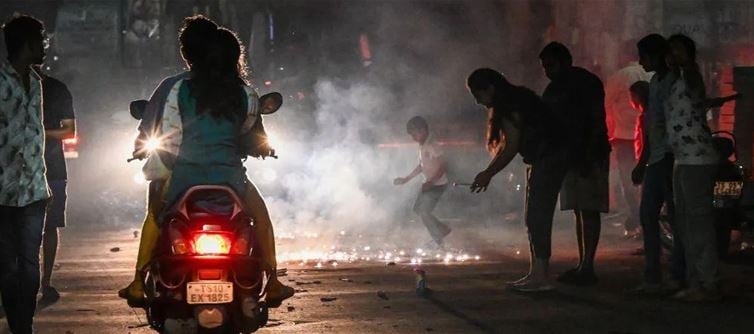
india glows — but the glow comes at a cost.
As millions of lamps flicker and firecrackers explode across the sky, the country celebrates not just light over darkness, but also wrestles with the shadows it casts — choking air, burning skies, and the timeless tug-of-war between tradition and survival.
1. The Night india Doesn’t Sleep — It Burns Bright.
Every corner of the nation bursts into a spectacle of sound and color. Streets glisten with diyas, homes hum with joy, and the air vibrates with celebration. But behind the brilliance lies a brutal reality — a thick haze slowly creeping across the skies.
2. When the air Turns to Ash — The Price of Celebration.
Northern india, already gasping through the winter smog, faces its worst week of air quality. Each cracker that lights up the sky leaves behind a toxic reminder — the thin line between joy and suffocation.
3. “Green Crackers” — A Promise Wrapped in Smoke.
The supreme Court’s decision to allow “green crackers” in delhi was meant to strike a balance between festivity and responsibility. They claim to release 20–30% less pollution — but experts argue that’s a marketing illusion, not a miracle cure. The question remains: Can india truly have an eco-friendly explosion?
4. Laws, Bans, and Broken Rules — The Annual Ritual of Defiance.
Every year, states ban or restrict firecrackers. Every year, the bans are broken. The smoke, the sound, and the spirit continue to rise, while enforcement goes up in flames faster than a sparkler on diwali night.
5. Beyond the Smoke — The heart of diwali Still Beats Pure.
Strip away the fire and the noise, and diwali remains a deeply human celebration. Families gather, lamps flicker in windows, and kitchens overflow with laddus, kheer, and love. It’s a night when every Indian, no matter where they are, feels at home.
6. The Economy’s Biggest Glow-Up.
Markets roar to life. From gold jewelry to sweet boxes, diwali is India’s unofficial economic festival — a trillion-rupee surge of consumer spending, gifting, and joy. For traders and small businesses, it’s not just a celebration; it’s survival.
7. Colors, culture, and Karma.
Homes get scrubbed clean, new clothes bought, and entrances bloom with rangolis — intricate designs meant to invite Goddess Lakshmi, the deity of wealth. diwali isn’t just seen; it’s felt — in hearts, homes, and in the sacred hope that light always wins.
8. The festival That Unites — and Divides.
From Hindus to Sikhs, Jains to believers of no faith at all, Diwali’s light transcends religion. But the smoke divides — between those who celebrate and those who suffer. Between culture and climate. Between nostalgia and necessity.
9. The Ultimate Paradox — India’s Light and Shadow.
Every diya lit is a symbol of triumph. Every spark in the sky, a reminder of what’s lost. As india celebrates light’s victory over darkness, the smog thickens — a silent warning that even the brightest festival must face its shadow.
⚡TAGLINE / OUTRO
India shines brighter than ever — but in that brilliance, a question burns:
Can the country find a way to celebrate light… without losing its breath?




 click and follow Indiaherald WhatsApp channel
click and follow Indiaherald WhatsApp channel